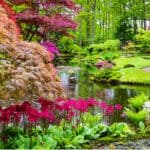Our site is reader supported, this means we may earn a small commission from Amazon and other affiliates when you buy through links on our site.
A Japanese garden is a style of garden from Japan, with the goal of creating a miniature landscape by carefully composing different arrangements of moss, rocks, water features, pruned trees, and sand or gravel raked in such a way that it looks like ripples in water.
Japanese gardens are typically small, but can be as large as you want. These gardens are supposed to be seen while sitting form a single lookout point like your porch or perhaps even a purpose-built tea room or garden room. Here you are meant to meditate about life’s purpose and the influence of nature.
That said, Japanese garden designs reflect the spiritual aspects and typically include a shallow, enclosed sandbox with sand or rocks of different sizes. Rocks and sand are the main elements in your garden, creating a scene of different “islands” in the sea. The sand itself represents the ocean and your other elements are the islands. With a Japanese garden, you can include many bonsai trees that are carefully pruned, large Ginkgo trees that give off a beautiful yellow colour when they bloom, and moss. You do not, though, need to put many plant or flower species. Traditionally, you would plant bright yellow plants for the yang energy and dark green plants for your yin energy.
We recently went a step further and did an article on the best plants for Japanese gardens which included bamboo, flowering cherry trees, ferns, rhododendrons and more. You can read this article here.
Size matters
The most important thing here is to arrange your garden so that it is pleasing to the eye so that you can relax. Consider the size of the space you have. You do not have to allocate all of your back garden to a Japanese garden design. You can create a small garden in one part of your garden, or transform your entire space. You are going to need a lot of sand and wherever you put sand, put a wood border or box to keep it contained. Rake your sand once you have it in place. Create curved strokes, ripple patterns. Rake the sand three to four inches deep to get the best look. Remember, too, you can change the style and patterns any time you want.
Adding stonework and sand with ripples
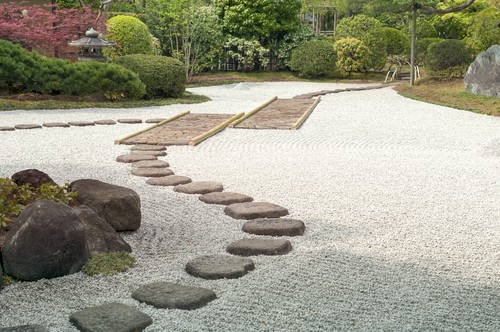
Add stones and pebbles to the garden. Arrange them well. If you have large rocks, submerge them partially in your sand box. Don’t put too many of them in one place or it will look cluttered. You can place them off-centre or stack three in the middle around which you rake the sand. Add Zen features like a stone Buddha, rock boulder, statue, or anything else that you prefer. Incorporate some plants and be sure to build a clear path through the garden. Stone paths are a great way to add to the design.
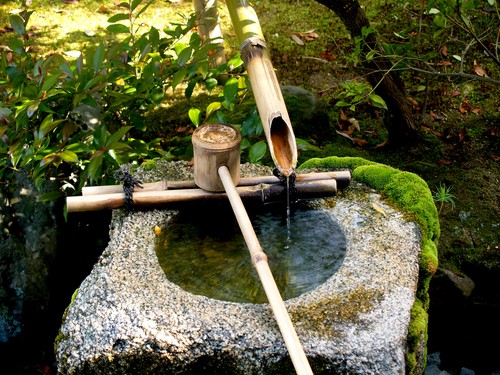
Not all Japanese gardens are dry. The rock part that most people associate with Buddhism and Zen gardens are just one part of Japanese gardens. You can add ponds, water features, and in so doing add positive energy to the garden. If you incorporate water, such as a small stream or pond, investing in large boulders that rise a few inches above the water and complete your path across the water is best.
Build a Bridge to add atmosphere and character
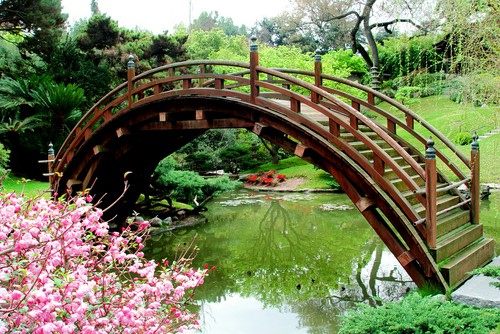
If you have a stream running through your garden or you have installed a pond as part of your design, a walking bridge is important. Small footbridges add atmosphere and character to a Japanese garden. Exotic hardwood is the best option for the structures as it is almost impervious to water damage and implement weather.
Adding a bridge to the walking path through your Japanese garden will help to create a relaxed mood and of course still be functional. Koi ponds are a great place to add bridges. With a small walkway that spans around your Koi pond, and a bridge that goes across you have the opportunity to look down into the water and watch your fish at play. This is not only a source of relaxation for adults but provides children with hours of entertainment.
Adding lighting to your Japanese garden
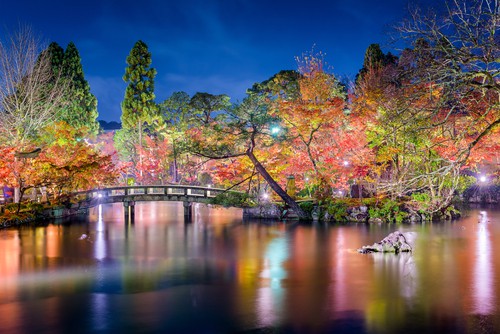
Lighting is great for larger spaces especially Japanese gardens. Before you set up the lights you need to consider how you want your garden to the lit. You might want Japanese lanterns to provide illumination and create atmosphere. If you plan on engaging in family activities, playing outside, you might need brighter lights compared to the small lights you would install along a footpath for Romantic midnight strolls.
When you are creating your garden you might want a romantic atmosphere in the garden in which case individual torches give you just enough light to safely walk around during dusk without ruining the mood. However, if you have a deck, bridge, or a wooden walking trail you can get lighting built into a railing system so you can easily follow the path without ruining the atmosphere.
Finally, consider adding a structure like a pagoda or a pergola with a garden bridge and wooden seating areas for relaxation and reflection.

